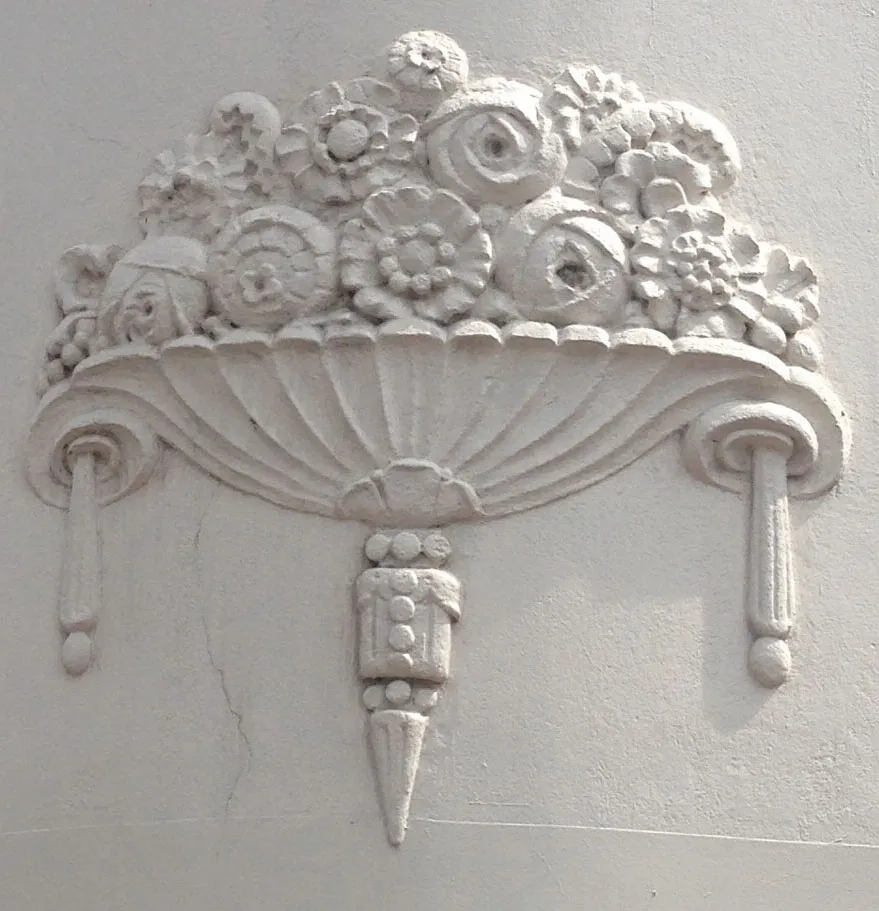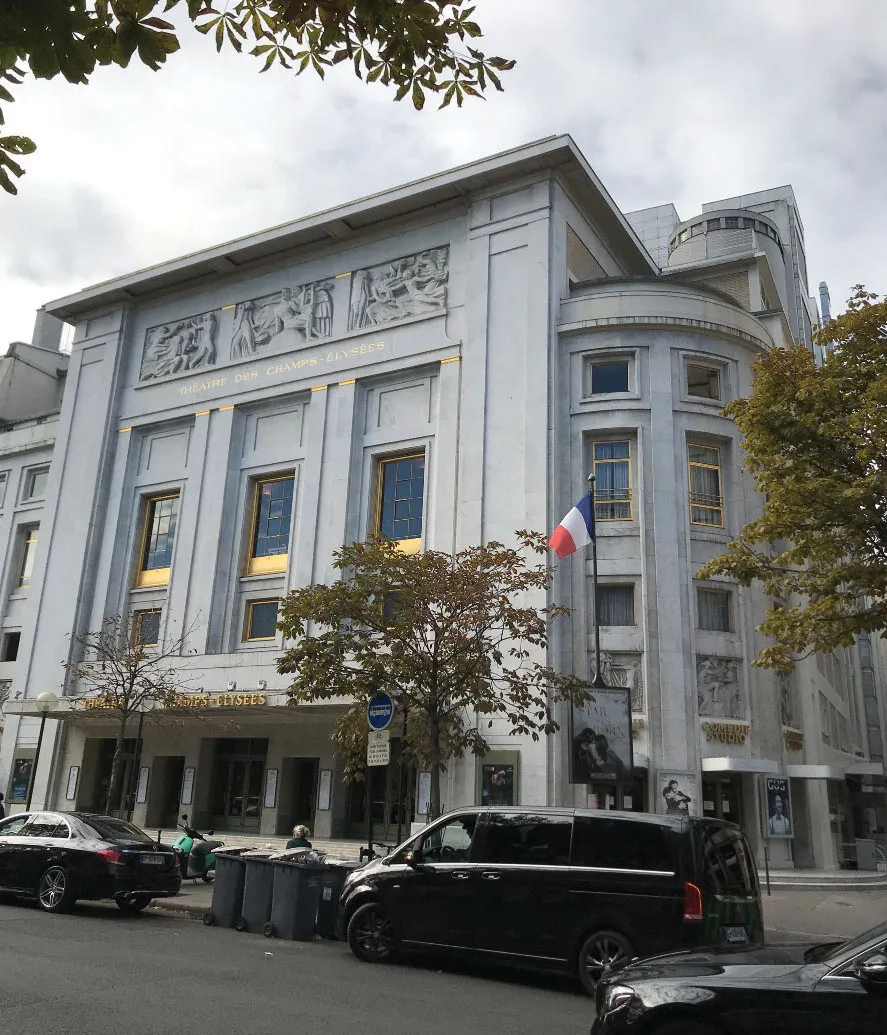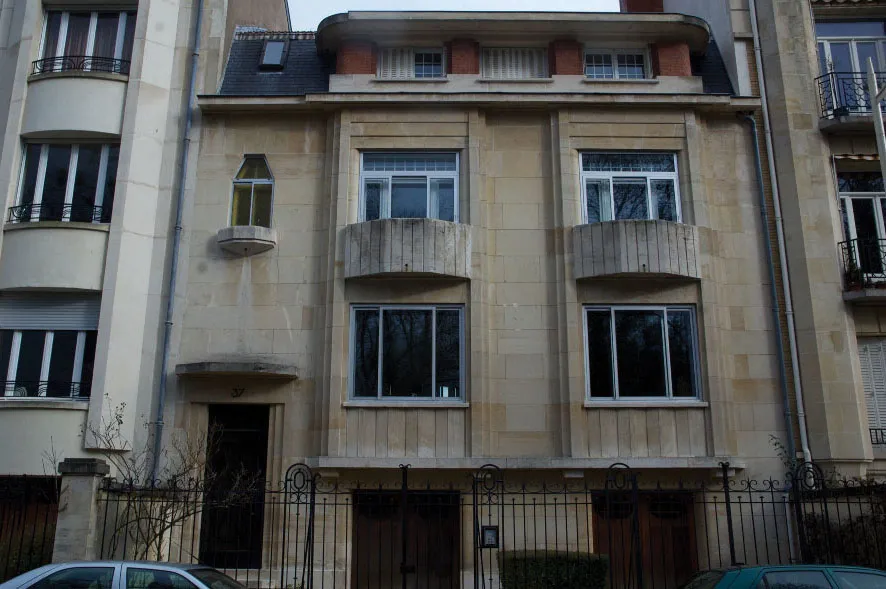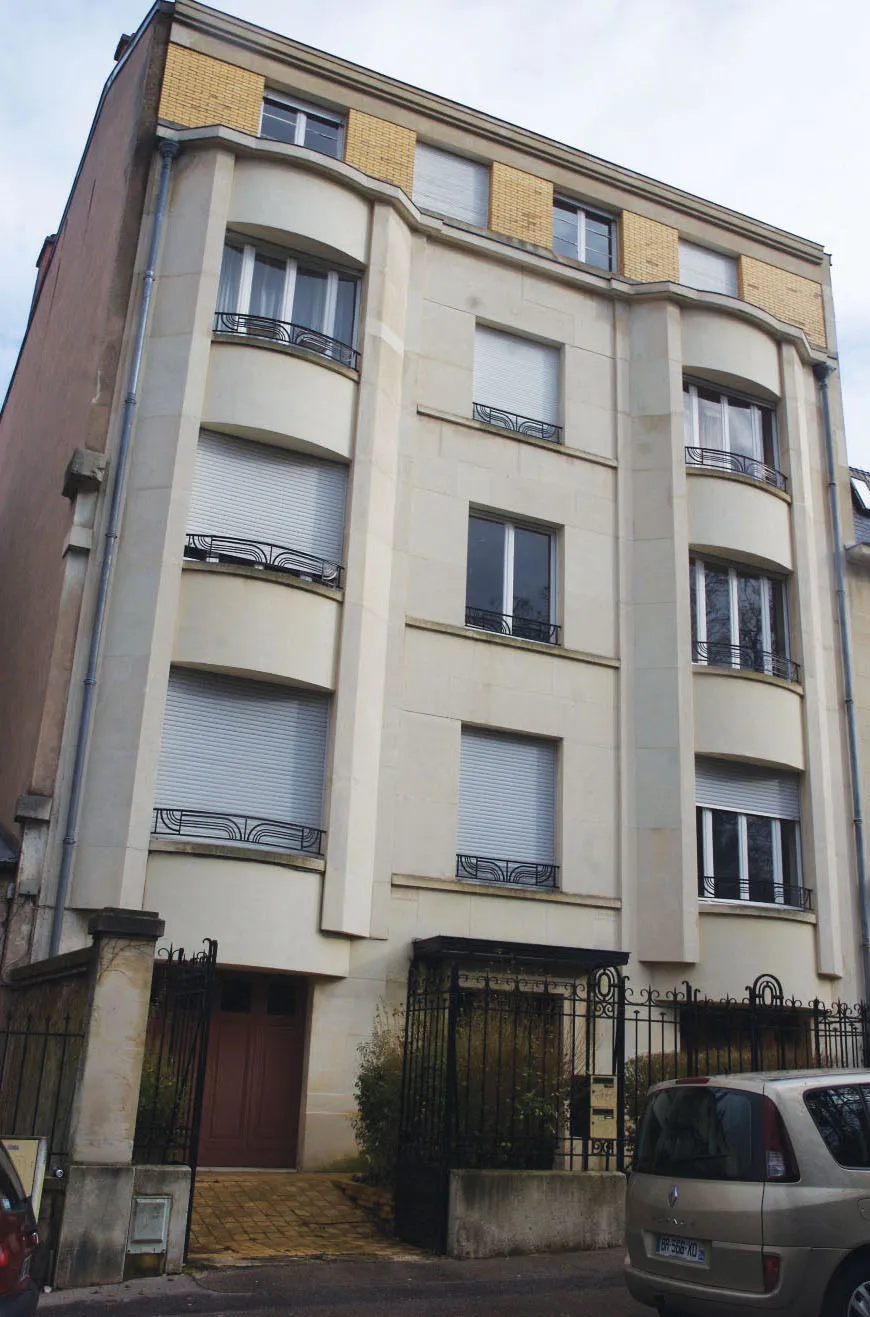![]()
Chapter 1
POST-FIRST WORLD WAR FRANCE
From The Start of a New Architectural Vocabulary and Style to Classical Modernism
Théâtre des Folies-Bergère, Paris. Detail of relief sculpture by Maurice Pico, of the dancer Anita Barka. 1926–27.
France – the birthplace of Art Deco. Some of its proponents/practitioners are very well known: furniture makers, Jacques Rhulemann; jewellers, Raymond Templier; interior decorators, Jean Dunand. Perhaps beyond the name of Le Corbusier and possibly Robert Mallet-Stevens, most people would find it difficult to summon up the names of any other French architects working during this period. To list just a few of the most important names is to shine a necessary spotlight on a little-known group who deserve so much more attention: Yves Hémar; Desmet and Doutrelong; Auguste and Gustave Perret; Robert Mallet-Stevens; Joseph Hiriart; Emile Bluysen ; Pierre Patout; Emile Dubuisson; Henri Sauvage; Henri Zipcy; Louis-Hippolyte Boileau; Auguste Bluysen; Albert Laprade; Georges-Robert Lefort; Michel Roux-Spitz. Of these, a small number are represented in the architects’ case studies.
Building for the Future
With the Armistice and the subsequent reparations set by the Treaty of Versailles, France set about rebuilding its economy and the shattered towns, villages and cities of much of the north and east of the country. Such was the scale of the devastation and demand for new building that in places such as Arras, Lens, Lille and Nancy, whole towns and city districts would emerge in a new and radical departure from the pre-war dominant style of Art Nouveau and late nineteenth-century Haussmann-inspired Neo-Classicism.
Plaster decoration, stylized classical bowl of flower heads, Lille.
With its emphasis on greatly reduced and stylized decorative schemes, regional variations, historicism and the use of regional materials, this led to the development of a uniquely French style that in turn would be disseminated around the world. The opportunities that arose produced a new set of architectural champions, such names as Albert Baert, Albert Laprade and Emile Dubuisson, most of whose names today barely gain regional let alone national or international recognition.
France was quite unusual compared to its fellow Allies, having lost a significantly greater portion of its population in the First World War than any of its major Western Allies (some 1.4 million dead soldiers; 400,000 civilians killed and 4.2 million wounded) and proportionately suffered the greatest physical damage through invasion and war. In fact, the occupied portion of Northern and Eastern France made up just under 5 per cent of the French landmass, but that heavily industrialized region accounted for 64 per cent of its pig iron output, 24 per cent of its steel production and 40 per cent of its coal production.
Architecturally speaking, French Art Deco really starts prior to the First World War with one particular building, the radically designed Théâtre des Champs-Elysées in Paris, which was the work of Auguste Perret. The building, which was constructed between 1910 and 1913, would also go down in history for the most famous musically inspired riot in a theatre, caused by the first public performance of Stravinsky’s The Rite of Spring. The building certainly pointed the way forward, with its rather austere and mainly plain external facades graced only by the frieze of bas-relief panels, sculpted in what would become an Art Deco style by Antoine Bourdelle.
Auguste Perret, Théâtre des Champs-Elysées, Paris. 1911–13.
This building shares the distinction of being one of the earliest of its kind, along with Henri Sauvage’s first Art Deco designed structure, the 1913 Majorelle, also in Paris.
The First World War had halted any further development. Indeed the proposed government-sponsored international exhibition would also be put on hold until 1925. It is now widely seen that without the First World War, the development and introduction of Art Deco in France and beyond would have almost certainly taken place a decade prior to its much-heralded 1925 arrival.
The Treaty of Versailles would take into account the vast scale of reparation necessary to repair and rebuild.
Financially, France initially weathered the vagaries of the period relatively unscathed. The banking sector did not suffer nearly as badly as either Britain or America. This was partly due to the reparation payments being made by Germany and partly through government intervention to stave off rampant inflation. Taxes were increased and tax collecting improved. Whereas the American and British systems collapsed in 1929 to be followed by the devaluation of their currencies, France would manage to stave off the worst effects of the Great Depression until 1931 and devaluation of the Franc until 1936. The country’s unemployment never rose above 5 per cent. This relative financial stability supported ongoing reconstruction. The most important encouragement at the start of the period was the massive programme of rebuilding. The rebuilding would, of course, have a regional bias, as much of the country was physically unaffected by the war. I have chosen to spotlight the reconstruction in and around Lille. There was however an enormous amount taking place in other areas of the country such as Alsace Lorraine, particularly Nancy, and all along the site of the Western Front. These areas of reconstruction would very much incorporate the regional vernacular with the newly emergent decorative features, to bring forth a range of new hybrid styles.
Facade in Arras, stucco rendered with geometric forms and classical figure.
Facade in Arras, stucco rendered with stylized bowl of flowers.
Facade in Arras, stone faced with simple geometric forms.
Facade in Arras with stucco rendering, exposed brickwork, stylized wave pattern and geometric forms in coloured plaster. Wave pattern metalwork balconies.
In North Eastern France, such places as Arras and Bailleul would be reconstructed very much in a traditional regional and therefore Flemish-inspired vernacular. Arras in particular would restore its famous squares in an exact copy of the destroyed Dutch Flemish originals, whilst the Baroque cathedral would be recreated with some interesting internal Art Deco decorative touches. In Lens however, the opportunity was taken to rebuild most of the civic and public buildings in a more contemporary style, with the miners’ baths, railway station, town hall, post office and so on all taking on a distinctively fresh appearance. Now, smooth geometric shapes were being mixed with pared-down, highly stylized, largely floral decorative panels and features.
Outside of the war-ravaged regions, Art Deco took hold regionally in the seaside vacation areas of Brittany, the south-west Atlantic coast and most importantly the Riviera. In the major cities, such as Lyon, Toulouse, Marseilles, a familiar pattern emerged, with some public buildings and factories appearing in a variety of Art Deco styles.
Facade in Arras with stucco rendering, exposed brickwork, stylized wave pattern and geometric forms. Wave pattern metalwork balconies.
The Paris Exhibitions
However, it is in Paris where the impetus of major international fairs and exhibitions fuelled a particularly rich creation of Art Deco buildings. The exhibitions in Paris of 1925, 1931, 1934 and 1937 in particular acted not only as a showcase for French art, architecture and design, but also allowed for the ideas of other countries and other styles to stand alongside one another. In the case of the glorious so-called highpoint of Art Deco at the 1925 exhibition, there were three major Modernist interventions.
Firstly, and perhaps most famously, Le Corbusier’s Pavillon de l’Esprit Nouveau, the Soviet Union’s Pavilion and Robert Mallet-Steven’s information kiosk and tower, which would become a landmark at the 1925 exposition, all pointed to radically different alternatives to the newly emergent Art Deco.
Whereas neither the 1925 nor the 1934 exhibitions left permanent in situ buildings, the exhibition of 1931, the International Colonial Exposition, left Paris with one building, the Museum of the Colonies at La Porte Dorée. Built by Albert Laprade, Léon Bazin and Léon Bazin and Leon Jaussely, its long colonnade and front wall have bas-reliefs by Alfred Janniot, in a typically French use of Neo-Classicism with Art Deco flourishes.
The sculptures depict animals, plants and cultures from the French colonies. Finally, the 1937 Paris international exposition has left twice as many buildings as all of its interwar predecessors. Despite its relative lack of contemporary popular success, its buildings have certainly left Paris with a spectacular legacy. The Palais de Chaillot designed by Jacques Carlu, Louis-Hippolyte Boileau and Léon Azéma is on a monumental scale, heavily influenced by Neo-Classicism and built out of concrete and stone.
Opposite this and again in a Neo-Classical style is the Palais d’Iéna. Not far away is the Palais de Tokyo, now home to the Paris City Museum of Modern Art.
Finally, there is the former Museum of Public Works, again in a Neo-Classical inspired style, this time designed by Auguste Perret, with a colonnade, rotunda and impressive façade. Now it serves as the French Social and Environmental Council. It was all built (not surprisingly for Perret) out of reinforced concrete.
These exhibitions taken as a whole would likewise reveal the steady change that was taking place as Art Deco transformed itself, with the currents of European Modernism, the Bauhaus, Constructivism, American Art Deco in the guise of Streamline Moderne and eventually International Modernism, all rapidly transmogrifying into a style that was also effectively acting as a barometer of public taste, aspirat...








